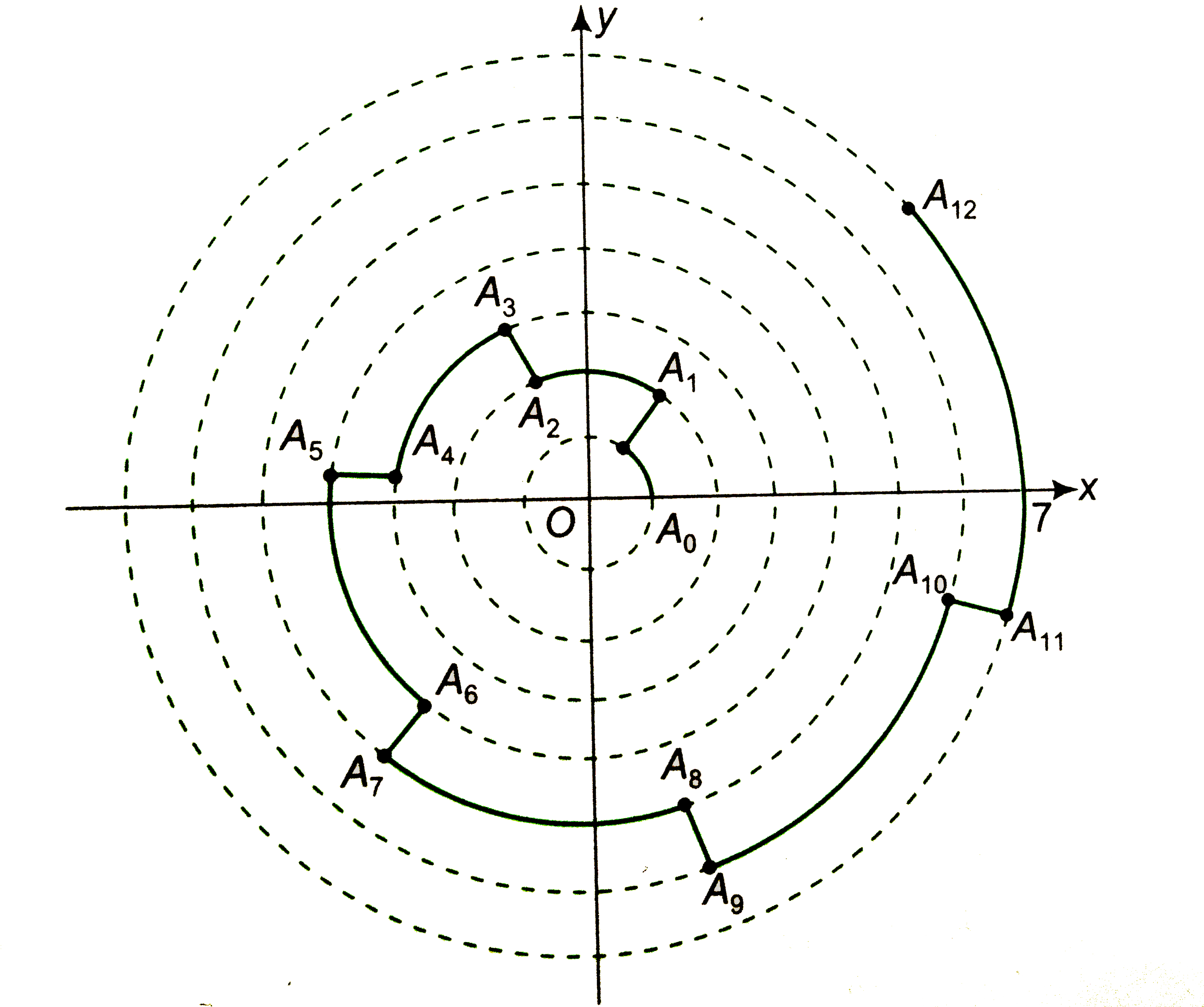For each natural number k, let Ck denotes the circle radius k centimeters in the counter-clockwise direction.After completing its motion on Ck, the particle moves to Ck+1 in the radial direction. The motion of the particle continues in this manner. The particle starts at (1,0).If the particle crosses the the positive direction of the x-axis for first time on the circle Cn,then n equal to
The motion of the particle on the circles is shown with bold lines in the figure starting at A0(1,0). Note that on every circle the particle tracels just 1 rad. The particle crosses the positive direction of the x-axis first time on Cn, where n is the least positive integer such that n≥2π⇒n=7.

Topper's Solved these Questions
- BOOK - CENGAGECHAPTER - TRIGONOMETRIC FUNCTIONS EXERCISE - Exercise 2.18videos
TRIGONOMETRIC FUNCTIONS
- BOOK - CENGAGECHAPTER - TRIGONOMETRIC FUNCTIONS EXERCISE - Exercise 2.28videos
TRIGONOMETRIC FUNCTIONS
- BOOK - CENGAGECHAPTER - TRIGONOMETRIC EQUATIONSEXERCISE - Archives (Matrix Match Type)1videos
TRIGONOMETRIC EQUATIONS
- BOOK - CENGAGECHAPTER - TRIGONOMETRIC RATIOS AND TRANSFORMATION FORMULASEXERCISE - Matrix Match Type1videos
TRIGONOMETRIC RATIOS AND TRANSFORMATION FORMULAS
Similar Questions
For each natural number k. Let Ck denotes the circle with radius k centimetres and centre at origin. On the circle Ck a particle moves k centrimetres in the counter-clockwise direction . After completing its motion on Ck the particle moves to Ck+1 in the radial direction . The motion of the particle continue in this manner. The particle starts at ( 1,0). If the particle crosses the positive direction of the X -axis for the first time on the circle Cn, then n=__________________.
View SolutionThe velocity of a particle moving in the positive direction of the X-axis varies as V=K√S where K is a positive constant. Draw V−t graph.
View Solution
Knowledge Check
- Question 1 - Select One
For each positve real number k, let Ck denotes the circle with centre at origin and radius k units. On a circle Ck particle α moves k units in the counter-clockwise direction. After completing its motion on Ck, the particle moves onto the circle Ck+1 in same well defined manner, where r>0. The motion of particle continues in this manner.
Let the particle starts from the point A(2,0) and moves π2 units on circle C2 in the counter clockwise direction, then moves on circle C3 along tangential peth, let this straight the (tangential path traced by particle) intersect the circle C3 at points A and B. then tangents at A and B intersect atA(sqrt2, sqrt2)B(9,9)C(92√2,92√2)D(9√2,9√2) - Question 2 - Select One
For each positve real number k, let Ck denotes the circle with centre at origin and radius k units. On a circle Ck particle α moves k units in the counter-clockwise direction. After completing its motion on Ck, the particle moves onto the circle Ck+1 in same well defined manner, where r>0. The motion of particle continues in this manner.
Let k∈l'andr=1, particle moves in the radial direction from Ck to Ck+1. If particle starts from the point (−1,0), thenAIt will cross the x-axis again at (3,0)BIt will cross the x-axis again at (4,0)CIt will cross the positive y-axis again at (0,4)DIt will cross the positive y-axis again at (0,5) - Question 3 - Select One
For each positve real number k, let Ck denotes the circle with centre at origin and radius k units. On a circle Ck particle α moves k units in the counter-clockwise direction. After completing its motion on Ck, the particle moves onto the circle Ck+1 in same well defined manner, where r>0. The motion of particle continues in this manner.
Let k∈l+andr∈R, particle moves tangentially from Ck to C_(k+r')suchtˆ≤n>hoftan≥ntisequal→kunitsitself.Ifpartic≤⋆tsomtehp∮(2,0), thenAthe particle will cross positive x-axis again for 2√2<x<4Bthe particle will cross positive x -axis again at x=2√2Cthe particle will cross positive x-axis again for 4 lt x lt 4 sqrt2Dthe particle will cross positive x-axis again at x=3
The velocity components of a particle moving in the xy plane of the reference frame K are equal to vx and vy. Find the velocity v′ of this particle in the frame K in the positive direction of its x axis.
View SolutionThe position vector →r of a particle points along the positive direction of a z axis. If the torque on the particle is (a) zero, (b) in the negative direction of x, and ( c) in the negative direction of y, in what direction is the force causing the torque?
View SolutionA particle moves along the X-axis. Its X-coordinate varies with time according to the expression x=4t+2r2, where x is in meters and t is in seconds. The position-time graph for this motion is shown in the figures previously. Note that the particle moves in the negative X-direction for the first second of motion, is at rest at the moment t=1s, and then heads back in the positive X-direction for t>1s.
Find the displacement of the particle in the time interval t=0 s to t=1 s.View SolutionA particle moves in the frame K with a velocity v at an angle θ to the x axis. Find the corresponding angle in the frame K′ moving with a velocity V relative to the frame K in the positive direction of its x axis, if the x and x′ axes of the two frames coincide.
View SolutionA particle moving along the X-axis executes simple harmonic motion, then the force acting on it is given by
where, A and K are positive constants.View Solution

